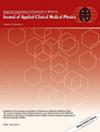Tumor-driven SRS VMAT planning: Regression models for intermediate and low dose spillage
Abstract
Purpose
Stereotactic radiosurgery (SRS) for brain metastases using volumetric modulated arc therapy (VMAT) is increasingly utilized. While high-dose conformity guidelines relative to tumor volume exist, recommendations for intermediate and low-dose regions remain undefined. This study explores tumor-specific characteristics and new dosimetric parameters to develop regression models for standardizing intracranial SRS planning.
Materials and Method
We introduce two dosimetric quantities: R6Gy, the 6 Gy cloud volume ratio to the PTV, and %D1cm, the maximum dose at 1 cm from the PTV relative to the prescribed dose. These, alongside R50% and the volume of normal brain receiving 12 Gy (V12Gy), were analyzed retrospectively in 290 VMAT SRS plans from 151 patients treated between January 2021 and September 2023. The data were stratified into single- and three- fraction arms. Statistical tests, including Spearman's rank correlation, and Normalized Mutual Information (NMI) evaluated relationships between dosimetric parameters, number of metastases (n), and total PTV volume, PTVTotal. Significant correlations were modeled using regression analysis.
Results
Strong correlations were found between PTVTotal and all dosimetric metrics in the single-fraction arm; weaker but significant correlations were noted in the three-fraction arm. Power-law regression best described R50% and R6Gy, while linear regressions best described %D1cm and V12Gy. Moderate monotonic correlations were observed between n and the dosimetric metrics.
Conclusion
This study proposes regression-based models for predicting dose spill based on tumor burden, total PTV volume and number of targets. These models provide a framework for model-based SRS planning, offering clinical physicists patient-specific guidance to improve consistency, optimize plan quality, and support future standardization efforts.





 求助内容:
求助内容: 应助结果提醒方式:
应助结果提醒方式:


